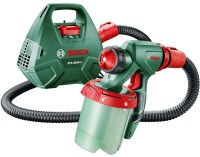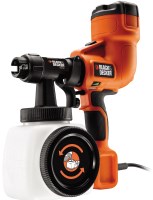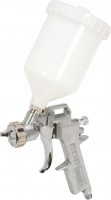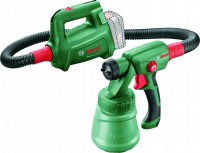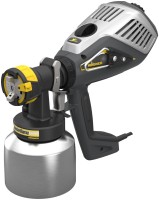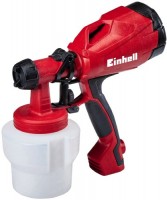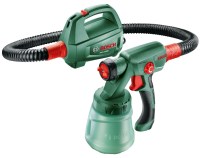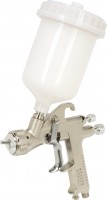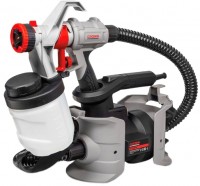Paint Sprayers Sealey
All Paint Sprayers Advanced filters → |
You might be interested in
Paint Sprayers: specifications, types
Device
— Airbrush. General purpose spray guns — in other words, traditional spray guns that do not belong to any of the specialized categories described below. At the same time, the functionality of such devices can be quite diverse — from relatively small tools for hard-to-reach areas and small areas to quite powerful performant solutions that are already approaching paint stations.
— Airbrush. A miniature variety of spray guns, distinguished primarily by very small nozzle sizes — less than 1 mm, and more often up to 0.5 mm. Thanks to this, airbrushes are optimally suited for delicate work, where accuracy is most important; with the help of such a tool, you can even create full-fledged paintings (for example, those same “airbrushes” that adorn cars).
— Roller. An improved version of the conventional paint roller, supplemented by a paint supply system. Thanks to this, additional convenience is provided during work: there is no need to periodically dip the roller into a container with paint, and the coating itself is applied as accurately and evenly as possible.
— Plaster. A variety of spray guns used not for painting, but for plastering. One of the characteristic features of such tools is the large diameter of the nozzle: thanks to this, it is not clogged with mortar particles and is easily cleaned after work is complet...ed. In addition, plaster guns are usually equipped with rather large (about 5 – 7 liters) own tanks; such a reservoir is usually supplemented with a handle for the convenience of holding the tool with the second hand.
— Paint station. Units designed for large volumes of work, where high performance is of decisive importance. A mandatory feature of paint stations are remote compressors (see below) of high power and large size, usually mounted on a stand or even a trolley for ease of transportation. And often there is no own paint tank at all, and the working composition is supplied from an external container (for example, a bucket). Also note that painting stations often allow two guns to be connected to one compressor at once (see below).
— Airbrush. A miniature variety of spray guns, distinguished primarily by very small nozzle sizes — less than 1 mm, and more often up to 0.5 mm. Thanks to this, airbrushes are optimally suited for delicate work, where accuracy is most important; with the help of such a tool, you can even create full-fledged paintings (for example, those same “airbrushes” that adorn cars).
— Roller. An improved version of the conventional paint roller, supplemented by a paint supply system. Thanks to this, additional convenience is provided during work: there is no need to periodically dip the roller into a container with paint, and the coating itself is applied as accurately and evenly as possible.
— Plaster. A variety of spray guns used not for painting, but for plastering. One of the characteristic features of such tools is the large diameter of the nozzle: thanks to this, it is not clogged with mortar particles and is easily cleaned after work is complet...ed. In addition, plaster guns are usually equipped with rather large (about 5 – 7 liters) own tanks; such a reservoir is usually supplemented with a handle for the convenience of holding the tool with the second hand.
— Paint station. Units designed for large volumes of work, where high performance is of decisive importance. A mandatory feature of paint stations are remote compressors (see below) of high power and large size, usually mounted on a stand or even a trolley for ease of transportation. And often there is no own paint tank at all, and the working composition is supplied from an external container (for example, a bucket). Also note that painting stations often allow two guns to be connected to one compressor at once (see below).
Type
The type is indicated by the energy source from which the spray gun operates. Nowadays, you can find pneumatic, electric( mains and battery), as well as mechanical and gasoline models. Here are their main features:
— Pneumatic. Spray guns powered by compressed air from an external compressor. In other words, only a spray gun (gun, airbrush, etc.) is included in the delivery package of such a tool; it requires a separate compressor to operate. At first glance, this creates certain inconveniences; however, such a configuration also has noticeable advantages. Firstly, you do not need to overpay for a compressor if it is already “on the farm” (a separate example of such a situation is a construction site where a powerful stationary compressor is used for several pneumatic tools). Secondly, the nozzle and compressor can be selected at your discretion, without relying on the equipment selected by the manufacturer. Thus, most modern spray guns are made precisely pneumatic. The unambiguous disadvantages of such devices include unsuitability for working with airless spray systems, however, such systems are used much less often than air ones, so this nuance is not key.
— Electric. In this case, spray guns powered by outlets are meant (battery models are placed in a separate category, see below). Dev...ices of this type consist of the nebulizer itself, as well as a compressor (built-in or remote). One of the advantages of this option is just the presence of a compressor, due to which, for the operation of such an airbrush, in fact, only an outlet is needed. In addition, both air and airless spray systems can be used in such units. The disadvantages of electric models include a higher cost than pneumatic ones, as well as the inability to select a working nozzle and a compressor separately — usually, spray guns of this type are sold as ready-made kits.
— Rechargeable. Spray guns equipped with electric compressors powered by their own batteries. The key advantage of such tools is battery life, the ability to work even if there are no outlets nearby. On the other hand, it is difficult to achieve high power and performance with a battery; the time of continuous operation of such atomizers is limited by the battery charge (and a source of electricity will still be required to replenish the charge); and the design itself turns out to be more complicated and more expensive than that of analogues powered by a socket. Therefore, battery spray guns nowadays have not received much distribution.
— Mechanical. Units in which the supply of paint is carried out due to the muscular strength of the user — in other words, for this you need to manually swing the pump lever. This scheme of operation is as simple and reliable as possible, but it is poorly suited for traditional sprayers. Therefore, "mechanics" nowadays is extremely rare, mainly among rollers (see "View").
— Petrol. Models with this type of power supply combine high power and independence from the power grid, but they are rather bulky, more difficult to operate and repair, more expensive (both in terms of their own cost and fuel price) and are generally designed for industrial outdoor use. . Therefore, they are poorly distributed and are used where, for one reason or another, electrical analogues are not applicable.
— Pneumatic. Spray guns powered by compressed air from an external compressor. In other words, only a spray gun (gun, airbrush, etc.) is included in the delivery package of such a tool; it requires a separate compressor to operate. At first glance, this creates certain inconveniences; however, such a configuration also has noticeable advantages. Firstly, you do not need to overpay for a compressor if it is already “on the farm” (a separate example of such a situation is a construction site where a powerful stationary compressor is used for several pneumatic tools). Secondly, the nozzle and compressor can be selected at your discretion, without relying on the equipment selected by the manufacturer. Thus, most modern spray guns are made precisely pneumatic. The unambiguous disadvantages of such devices include unsuitability for working with airless spray systems, however, such systems are used much less often than air ones, so this nuance is not key.
— Electric. In this case, spray guns powered by outlets are meant (battery models are placed in a separate category, see below). Dev...ices of this type consist of the nebulizer itself, as well as a compressor (built-in or remote). One of the advantages of this option is just the presence of a compressor, due to which, for the operation of such an airbrush, in fact, only an outlet is needed. In addition, both air and airless spray systems can be used in such units. The disadvantages of electric models include a higher cost than pneumatic ones, as well as the inability to select a working nozzle and a compressor separately — usually, spray guns of this type are sold as ready-made kits.
— Rechargeable. Spray guns equipped with electric compressors powered by their own batteries. The key advantage of such tools is battery life, the ability to work even if there are no outlets nearby. On the other hand, it is difficult to achieve high power and performance with a battery; the time of continuous operation of such atomizers is limited by the battery charge (and a source of electricity will still be required to replenish the charge); and the design itself turns out to be more complicated and more expensive than that of analogues powered by a socket. Therefore, battery spray guns nowadays have not received much distribution.
— Mechanical. Units in which the supply of paint is carried out due to the muscular strength of the user — in other words, for this you need to manually swing the pump lever. This scheme of operation is as simple and reliable as possible, but it is poorly suited for traditional sprayers. Therefore, "mechanics" nowadays is extremely rare, mainly among rollers (see "View").
— Petrol. Models with this type of power supply combine high power and independence from the power grid, but they are rather bulky, more difficult to operate and repair, more expensive (both in terms of their own cost and fuel price) and are generally designed for industrial outdoor use. . Therefore, they are poorly distributed and are used where, for one reason or another, electrical analogues are not applicable.
Power consumption
The power consumed by the operation of an electric tool (see "Type").
Most modern spray guns, even performant ones, have a rather low power: for example, models with more than 1 kW are extremely rare, and in most cases, power consumption does not exceed 500 W at all. So when connecting such equipment to sockets, there are usually no problems; only single units of high performance, requiring 3.5 kW or more, have to be connected according to special rules (directly to the shield). In other cases, data on power consumption is most often not needed for normal use and may be required only for specific tasks — for example, to calculate the load on an autonomous generator.
Most modern spray guns, even performant ones, have a rather low power: for example, models with more than 1 kW are extremely rare, and in most cases, power consumption does not exceed 500 W at all. So when connecting such equipment to sockets, there are usually no problems; only single units of high performance, requiring 3.5 kW or more, have to be connected according to special rules (directly to the shield). In other cases, data on power consumption is most often not needed for normal use and may be required only for specific tasks — for example, to calculate the load on an autonomous generator.
Rated pressure
Nominal air pressure in the spray gun.
The general meaning of this parameter depends on the type of instrument (see above). So, in pneumatic models, nominal pressure data is required for connection to an external compressor. It is this pressure that this compressor must create at the inlet to the atomizer; too low values will lead to a decrease in efficiency, too high are fraught with breakdowns and even accidents with injury to others.
In turn, for electric models, the nominal pressure is the air pressure created by the unit's own compressor; the complete atomizer was originally designed for the same pressure. So in this case, this parameter is more of a reference than practically significant; it may be useful only for connecting replacement nozzles to the compressor (or vice versa, for using an existing nozzle with a third-party compressor).
As for specific pressure values, they are primarily determined by the spray system (see below). The diversity here is quite high: the most modest units give out less than 2 bar, 2-5 bar compressors are quite popular , 5-10 bar models are relatively rare, and some powerful performance solutions provide a pressure of 100 bar or more.
The general meaning of this parameter depends on the type of instrument (see above). So, in pneumatic models, nominal pressure data is required for connection to an external compressor. It is this pressure that this compressor must create at the inlet to the atomizer; too low values will lead to a decrease in efficiency, too high are fraught with breakdowns and even accidents with injury to others.
In turn, for electric models, the nominal pressure is the air pressure created by the unit's own compressor; the complete atomizer was originally designed for the same pressure. So in this case, this parameter is more of a reference than practically significant; it may be useful only for connecting replacement nozzles to the compressor (or vice versa, for using an existing nozzle with a third-party compressor).
As for specific pressure values, they are primarily determined by the spray system (see below). The diversity here is quite high: the most modest units give out less than 2 bar, 2-5 bar compressors are quite popular , 5-10 bar models are relatively rare, and some powerful performance solutions provide a pressure of 100 bar or more.
Air consumption
Nominal air flow rate when the spray gun is operating in normal mode.
This parameter is of key importance for a pneumatic tool (see "Type"): the compressor to which such a sprayer is connected must provide the appropriate air supply rate, otherwise normal operation will not be possible. In turn, in electric models, this indicator is more of a reference — the complete compressor, by definition, corresponds to the characteristics of the sprayer, and it makes sense to pay attention to the flow rate only if the working nozzle of the electric spray gun is planned to be used with a "non-native" compressor.
This parameter is of key importance for a pneumatic tool (see "Type"): the compressor to which such a sprayer is connected must provide the appropriate air supply rate, otherwise normal operation will not be possible. In turn, in electric models, this indicator is more of a reference — the complete compressor, by definition, corresponds to the characteristics of the sprayer, and it makes sense to pay attention to the flow rate only if the working nozzle of the electric spray gun is planned to be used with a "non-native" compressor.
Paint consumption
Consumption of paint or other material (for example, mortar for plaster) when the spray gun is operating in normal mode.
The higher the flow rate, the more material the tool can apply per unit of time, the better it is suitable for processing large areas and for applying thick coatings. On the other hand, not all types of work require high productivity, and sometimes relatively low consumption is optimal. Detailed recommendations on this subject for different situations can be found in special sources.
The higher the flow rate, the more material the tool can apply per unit of time, the better it is suitable for processing large areas and for applying thick coatings. On the other hand, not all types of work require high productivity, and sometimes relatively low consumption is optimal. Detailed recommendations on this subject for different situations can be found in special sources.
Maximum viscosity
The maximum viscosity of the paint or other working material at which the spray gun is able to work normally. Specified in DIN units; a certain DIN in this case is the number of seconds it takes for a standard volume of paint (usually 100 mL) to pour out of a funnel with a strictly defined pour hole diameter (usually about 4 mm). Such a funnel (viscometer) can be supplied with the spray gun, but if necessary, it can be purchased separately.
Thus, the larger the DIN, the more viscous the composition is. And the larger the number indicated in the characteristics of the spray gun, the wider its capabilities, the thicker liquids can be poured into it without fear of clogging and breakage. At the same time, it should be taken into account that in fact it is not so often necessary to work with thick liquids — on the contrary, excessive viscosity worsens the quality of the coating, leads to streaks and increases the drying time. For example, most enamels and oil paints are used at a viscosity of about 20 DIN, latex paints up to 45 DIN, etc. General recommendations on this matter can be found in special sources, and specific ones can be found on the packaging of a particular brand of paint or other composition.
Thus, the larger the DIN, the more viscous the composition is. And the larger the number indicated in the characteristics of the spray gun, the wider its capabilities, the thicker liquids can be poured into it without fear of clogging and breakage. At the same time, it should be taken into account that in fact it is not so often necessary to work with thick liquids — on the contrary, excessive viscosity worsens the quality of the coating, leads to streaks and increases the drying time. For example, most enamels and oil paints are used at a viscosity of about 20 DIN, latex paints up to 45 DIN, etc. General recommendations on this matter can be found in special sources, and specific ones can be found on the packaging of a particular brand of paint or other composition.
Nozzle size
The diameter of the nozzle at the outlet of the spray gun.
It is from this nozzle that paint or other working material comes out. And the productivity and spot size at the exit depend on the diameter. Accordingly, larger nozzles are better suited for processing large surfaces, while smaller nozzles provide greater precision and accuracy. Thus, this parameter is directly related to the type of device (see above). There are also spray guns with a replaceable nozzle, when more than one nozzle is provided in the kit, which expands the possibilities of using the device.
It is from this nozzle that paint or other working material comes out. And the productivity and spot size at the exit depend on the diameter. Accordingly, larger nozzles are better suited for processing large surfaces, while smaller nozzles provide greater precision and accuracy. Thus, this parameter is directly related to the type of device (see above). There are also spray guns with a replaceable nozzle, when more than one nozzle is provided in the kit, which expands the possibilities of using the device.
Spraying
Spray method used by the spray gun.
— Pneumatic. Pneumatic (air) spray tools work on the principle of a spray gun: paint particles are captured by the air stream flowing from the nozzle and transferred to the surface to be painted. This method is standard for pneumatic tools, but it is also common in other types (see above). The advantages of pneumatics are the excellent uniformity of application and the aesthetic appearance of the resulting coating, as well as its versatility — it can be used both for small jobs and for large surfaces, for objects of any complexity and with almost any type of paint and varnish materials. And the equipment is relatively simple and inexpensive. The main disadvantages of this method are high fogging (which requires good ventilation and protective equipment, and also increases material consumption) and the need to dilute the material to a working consistency (which, in turn, affects the consumption of solvents).
— Airless. Airless spraying is based on forcing the paint material with a special high pressure pump; roughly speaking, the spray gun "spits out" the paint through a nozzle, spraying it into a stream of the desired shape. The key advantages of this method over the pneumatic one are, firstly, high productivity (including due to higher efficiency and lower material losses), and secondly, the absolute minimum of fogging. It is also worth noting the low consumption of solvents and a clear...border of the edges of the treated area. At the same time, the uniformity and appearance of the coating during such work is much worse than with air spraying, the uniformity is lower, and the equipment turns out to be expensive and difficult both in itself and in maintenance. Therefore, airless spray is recommended for large areas where productivity is more important than high quality. In addition, this option is indicated for rollers (see "View"): in them the technology is somewhat different from that described, but it also does not imply a supply of compressed air.
— Pneumatic. Pneumatic (air) spray tools work on the principle of a spray gun: paint particles are captured by the air stream flowing from the nozzle and transferred to the surface to be painted. This method is standard for pneumatic tools, but it is also common in other types (see above). The advantages of pneumatics are the excellent uniformity of application and the aesthetic appearance of the resulting coating, as well as its versatility — it can be used both for small jobs and for large surfaces, for objects of any complexity and with almost any type of paint and varnish materials. And the equipment is relatively simple and inexpensive. The main disadvantages of this method are high fogging (which requires good ventilation and protective equipment, and also increases material consumption) and the need to dilute the material to a working consistency (which, in turn, affects the consumption of solvents).
— Airless. Airless spraying is based on forcing the paint material with a special high pressure pump; roughly speaking, the spray gun "spits out" the paint through a nozzle, spraying it into a stream of the desired shape. The key advantages of this method over the pneumatic one are, firstly, high productivity (including due to higher efficiency and lower material losses), and secondly, the absolute minimum of fogging. It is also worth noting the low consumption of solvents and a clear...border of the edges of the treated area. At the same time, the uniformity and appearance of the coating during such work is much worse than with air spraying, the uniformity is lower, and the equipment turns out to be expensive and difficult both in itself and in maintenance. Therefore, airless spray is recommended for large areas where productivity is more important than high quality. In addition, this option is indicated for rollers (see "View"): in them the technology is somewhat different from that described, but it also does not imply a supply of compressed air.
Spray system
The type of spray system used in the device. Different spray systems differ in the format of work and, as a result, in individual practical nuances of use:
— HP (High Pressure) / CONV (conventional). One of the most famous and popular spray systems. The air pressure at the inlet and outlet of such spray guns is approximately the same. The advantages of HP systems are the simplicity of design, large working width, high paint application speed and relatively low air consumption. At the same time, the percentage of paint transfer in such sprayers is very low — more than half of the applied material bounces off the surface due to high speed and settles on surrounding objects. Another disadvantage is that the flow from the HP atomizer picks up fine dust and other "flying debris" heavily; because of this, additional grinding and polishing of the painted surface is often required.
— RP (Reduced Pressure). Modification of conventional (HP) atomizers, characterized by a slightly reduced outlet pressure. This allowed for some improvement in the transfer coefficient and reduced debris levels while maintaining the advantages of good performance, uniformity and low air consumption. Nevertheless, according to these indicators, such devices are still inferior to low-pressure models.
— HVLP (High Volume Low Pressure). Spray system with reduced outlet pressure (a...pprox. 0.7 bar) and large air volumes. One of the key advantages of such devices is a high ink transfer coefficient of at least 65%. In addition, the low speed of the paint supply reduces the level of debris: there are relatively few turbulences that “pull” debris along with them. The main disadvantage of HVLP systems can be called high air consumption; not every compressor can handle such an atomizer. In addition, they require additional filters to protect against oil and moisture entering the air during high compressor loads; and you can work with such a device only at a short distance (usually up to 15 cm), and in order to avoid drips, a certain skill is required.
— HVLP-II (New High Volume Low Pressure). The second generation of HVLP (see the relevant paragraph), which has a number of improvements compared to the original, but is generally similar.
— LVLP (Low Volume Low Pressure) / Trans-Tech. Spray systems developed as an improvement to HVLP. With the same advantages (high transfer coefficient, minimum debris), they consume much less air and have softer requirements for compressors and hoses. In addition, LVLP systems are less sensitive to pressure drops, and the effective spraying range in them reaches 25 – 30 cm. Of the notable disadvantages of this option, one can only mention a rather high cost.
— HVMP (High Volume Middle Pressure). Spray systems with high air flow and medium outlet pressure. Compared to HVLP, due to the higher pressure, they give a slightly lower ink transfer efficiency, but greater uniformity and range.
— LVMP (Low Volume Middle Pressure). Spray systems with low air consumption and medium pressure; a kind of modification of LVLP, characterized by higher pressure. Due to this, the cost is somewhat reduced, productivity, uniformity of application and capture width are increased; however, paint consumption is higher and the finished surface is rougher than original LVLP.
— HTE (High Transfer Efficiency). This marking is used in spray systems for which a high transfer coefficient is claimed by the manufacturers. In terms of characteristics, they are most often similar to LVLPs (see the relevant paragraph) — in particular, they have a rather large effective range. However, specific features in each case should be clarified separately.
— EA (Excellent Atomization). The main feature of such systems, in accordance with the name, is a very high degree of atomization of the material. Other performance characteristics in such systems may be different, these points should be clarified separately.
— HEA (High Efficiency Airless). Proprietary airless spray technology (see "Spray") used in the Wagner brand technique. Reduces paint wastage by more than 50% compared to more traditional systems, as well as more even material distribution, according to the creators. Suitable for water and oil based coatings.
MP (Middle Pressure). Transitional option between the HP and RP described above: it provides a slightly lower working pressure compared to HP, but not as low as in RP. For a number of reasons, it did not receive distribution.
HD (Heavy Duty). A marketing designation used on individual sprayers, typically high-capacity, high-volume sprayers. The specific characteristics of such systems should be clarified separately.
— HP (High Pressure) / CONV (conventional). One of the most famous and popular spray systems. The air pressure at the inlet and outlet of such spray guns is approximately the same. The advantages of HP systems are the simplicity of design, large working width, high paint application speed and relatively low air consumption. At the same time, the percentage of paint transfer in such sprayers is very low — more than half of the applied material bounces off the surface due to high speed and settles on surrounding objects. Another disadvantage is that the flow from the HP atomizer picks up fine dust and other "flying debris" heavily; because of this, additional grinding and polishing of the painted surface is often required.
— RP (Reduced Pressure). Modification of conventional (HP) atomizers, characterized by a slightly reduced outlet pressure. This allowed for some improvement in the transfer coefficient and reduced debris levels while maintaining the advantages of good performance, uniformity and low air consumption. Nevertheless, according to these indicators, such devices are still inferior to low-pressure models.
— HVLP (High Volume Low Pressure). Spray system with reduced outlet pressure (a...pprox. 0.7 bar) and large air volumes. One of the key advantages of such devices is a high ink transfer coefficient of at least 65%. In addition, the low speed of the paint supply reduces the level of debris: there are relatively few turbulences that “pull” debris along with them. The main disadvantage of HVLP systems can be called high air consumption; not every compressor can handle such an atomizer. In addition, they require additional filters to protect against oil and moisture entering the air during high compressor loads; and you can work with such a device only at a short distance (usually up to 15 cm), and in order to avoid drips, a certain skill is required.
— HVLP-II (New High Volume Low Pressure). The second generation of HVLP (see the relevant paragraph), which has a number of improvements compared to the original, but is generally similar.
— LVLP (Low Volume Low Pressure) / Trans-Tech. Spray systems developed as an improvement to HVLP. With the same advantages (high transfer coefficient, minimum debris), they consume much less air and have softer requirements for compressors and hoses. In addition, LVLP systems are less sensitive to pressure drops, and the effective spraying range in them reaches 25 – 30 cm. Of the notable disadvantages of this option, one can only mention a rather high cost.
— HVMP (High Volume Middle Pressure). Spray systems with high air flow and medium outlet pressure. Compared to HVLP, due to the higher pressure, they give a slightly lower ink transfer efficiency, but greater uniformity and range.
— LVMP (Low Volume Middle Pressure). Spray systems with low air consumption and medium pressure; a kind of modification of LVLP, characterized by higher pressure. Due to this, the cost is somewhat reduced, productivity, uniformity of application and capture width are increased; however, paint consumption is higher and the finished surface is rougher than original LVLP.
— HTE (High Transfer Efficiency). This marking is used in spray systems for which a high transfer coefficient is claimed by the manufacturers. In terms of characteristics, they are most often similar to LVLPs (see the relevant paragraph) — in particular, they have a rather large effective range. However, specific features in each case should be clarified separately.
— EA (Excellent Atomization). The main feature of such systems, in accordance with the name, is a very high degree of atomization of the material. Other performance characteristics in such systems may be different, these points should be clarified separately.
— HEA (High Efficiency Airless). Proprietary airless spray technology (see "Spray") used in the Wagner brand technique. Reduces paint wastage by more than 50% compared to more traditional systems, as well as more even material distribution, according to the creators. Suitable for water and oil based coatings.
MP (Middle Pressure). Transitional option between the HP and RP described above: it provides a slightly lower working pressure compared to HP, but not as low as in RP. For a number of reasons, it did not receive distribution.
HD (Heavy Duty). A marketing designation used on individual sprayers, typically high-capacity, high-volume sprayers. The specific characteristics of such systems should be clarified separately.
Container
The location of the paint reservoir relative to the regular working position of the spray gun. Note that there are models without a tank, and this indicator does not affect the quality of painting, the differences lie in other points:
— Lower. The lower arrangement allows the use of fairly large containers, while maintaining the ability to work with one hand. In addition, many models allow you to put the gun directly on the tank.
— Upper. The top position of the tank provides a fairly comfortable balance; and due to the fact that the paint enters the gun under its own weight, it becomes possible to work with more viscous materials than with the lower location. However the volume of the tank is usually less; the exception is plaster spray guns (see "View"), in which the tank is supplemented with a handle to hold the tool in two hands.
— Lateral (swivel). At first glance, such models look like overhead spray guns; however, in them, the reservoir is not connected directly from above, but from the side, through an L-shaped tube. The attachment of this tube allows you to rotate the tank, so that the spray gun can be used with equal convenience for both vertical surfaces (such as walls) and horizontal surfaces (such as the ceiling).
— Detached. Reservoirs located separately f...rom the spray gun and connected to it by a hose for supplying paint. This option is considered optimal for large volumes of work. There are several reasons for this: firstly, the user has to hold only a relatively light pistol in his hands, which reduces fatigue; secondly, the tank can be made quite roomy — up to several liters. Among the shortcomings, one can note the general bulkiness and increased cost of such spray guns.
— Lower. The lower arrangement allows the use of fairly large containers, while maintaining the ability to work with one hand. In addition, many models allow you to put the gun directly on the tank.
— Upper. The top position of the tank provides a fairly comfortable balance; and due to the fact that the paint enters the gun under its own weight, it becomes possible to work with more viscous materials than with the lower location. However the volume of the tank is usually less; the exception is plaster spray guns (see "View"), in which the tank is supplemented with a handle to hold the tool in two hands.
— Lateral (swivel). At first glance, such models look like overhead spray guns; however, in them, the reservoir is not connected directly from above, but from the side, through an L-shaped tube. The attachment of this tube allows you to rotate the tank, so that the spray gun can be used with equal convenience for both vertical surfaces (such as walls) and horizontal surfaces (such as the ceiling).
— Detached. Reservoirs located separately f...rom the spray gun and connected to it by a hose for supplying paint. This option is considered optimal for large volumes of work. There are several reasons for this: firstly, the user has to hold only a relatively light pistol in his hands, which reduces fatigue; secondly, the tank can be made quite roomy — up to several liters. Among the shortcomings, one can note the general bulkiness and increased cost of such spray guns.
Container volume
The total volume of the paint reservoir supplied with the gun. Large tank, on the one hand, allows you to "charge" a lot of material and work for a long time. On the other hand, it increases the size and weight of the device; and a large amount of paint will also weigh accordingly (although for models with a separate tank location - see above - this is not critical). Therefore, the thinner and more delicate the work for which the spray gun is designed, the, as a rule, the smaller the tank volume : for example, in airbrushes (see "View") it rarely exceeds 50 ml, and in plaster models, in turn, can be measured liters. Therefore, most models have a volume of no more than a liter, namely 500 ml, 600 ml, 700 ml, 800 ml, 1000 ml.
Tank material
The material from which the complete reservoir of the spray gun is made.
— Plastic. Plastic is characterized by a combination of low cost with lightness and reliability. It is somewhat inferior to metal in strength, however, in the case of tanks for spray guns, this is not critical; in addition, the plastic tank can be made transparent, which makes it easier to keep track of the paint level. Thanks to all this, plastic is found in devices of all types and price categories. Among its shortcomings, sensitivity to certain types of solvents can be noted; however, there are resistant varieties of plastic that are practically devoid of this feature.
— Metal. The main advantage of metal tanks is high strength and reliability. On the other hand, they are noticeably more expensive and heavier than plastic ones, and besides, they are not transparent (at best, a built-in indicator in the form of a window can be provided). Because of this, the metal is less common.
— Glass. The glass reservoirs are transparent and allow you to easily control the amount of remaining paint. In addition, this material is chemically inert and compatible with almost any working substance. However, glass has a serious drawback — fragility, which is why it has not received much distribution and is found only in some models of airbrushes (see "View").
— Plastic. Plastic is characterized by a combination of low cost with lightness and reliability. It is somewhat inferior to metal in strength, however, in the case of tanks for spray guns, this is not critical; in addition, the plastic tank can be made transparent, which makes it easier to keep track of the paint level. Thanks to all this, plastic is found in devices of all types and price categories. Among its shortcomings, sensitivity to certain types of solvents can be noted; however, there are resistant varieties of plastic that are practically devoid of this feature.
— Metal. The main advantage of metal tanks is high strength and reliability. On the other hand, they are noticeably more expensive and heavier than plastic ones, and besides, they are not transparent (at best, a built-in indicator in the form of a window can be provided). Because of this, the metal is less common.
— Glass. The glass reservoirs are transparent and allow you to easily control the amount of remaining paint. In addition, this material is chemically inert and compatible with almost any working substance. However, glass has a serious drawback — fragility, which is why it has not received much distribution and is found only in some models of airbrushes (see "View").
Replaceable container
The presence of a replaceable tank will be appropriate when completely different jobs are carried out with a spray gun with significantly different amounts of paint. Sometimes it is inappropriate to fill the 800 mL tank if you need to paint small volumes. It is to save paint consumption and comfort in use (weight also plays a role) in some spray guns a replaceable tank of a smaller capacity is provided.
2 guns connection
The ability to simultaneously connect two guns or other sprayers to the device at once(and in some models, more than two at once).
This feature is found exclusively in painting stations (see "View") — in such units, you can easily install sufficiently powerful compressors that can supply air to several sprayers at the same time. In general, models for several guns belong to professional industrial equipment: they allow several people to work at the same time, but the stations themselves turn out to be heavy and bulky, and they are expensive. Therefore, it is worth paying attention to this option in cases where speed and performance are crucial.
This feature is found exclusively in painting stations (see "View") — in such units, you can easily install sufficiently powerful compressors that can supply air to several sprayers at the same time. In general, models for several guns belong to professional industrial equipment: they allow several people to work at the same time, but the stations themselves turn out to be heavy and bulky, and they are expensive. Therefore, it is worth paying attention to this option in cases where speed and performance are crucial.
Pressure gauge
The spray gun has a built-in pressure gauge — a device for measuring pressure.
Such equipment is found in two types of spray guns: pneumatic sprayers (see "Type") and paint stations (see "View"). In the first case, the pressure gauge is installed on the atomizer itself; it allows you to control the pressure supplied to the tool from an external compressor. In turn, in painting stations, a pressure gauge is placed on the compressor and is responsible for measuring the air pressure supplied to external sprayers; this is especially useful when using third-party guns, whose characteristics (including operating pressure) may differ markedly from those of the spray station's complete sprayers.
Such equipment is found in two types of spray guns: pneumatic sprayers (see "Type") and paint stations (see "View"). In the first case, the pressure gauge is installed on the atomizer itself; it allows you to control the pressure supplied to the tool from an external compressor. In turn, in painting stations, a pressure gauge is placed on the compressor and is responsible for measuring the air pressure supplied to external sprayers; this is especially useful when using third-party guns, whose characteristics (including operating pressure) may differ markedly from those of the spray station's complete sprayers.
Remote compressor
The presence of a remote compressor in the design of the spray gun.
This feature means that, firstly, the unit is equipped with its own compressor (that is, it is electrical, see "Type"), and secondly, this compressor (or pump for airless spraying) is made separately from the sprayer and is connected to it special hose. Thanks to this design, the atomizer itself is as light and compact as possible, which is especially important for large volumes of work or for delicate work that requires maximum precision and accuracy. In light of the latter, all electric airbrushes (see "View") are equipped with remote compressors, although this feature is also found in other types of spray guns — in particular, this design is mandatory for paint stations (see ibid.).
This feature means that, firstly, the unit is equipped with its own compressor (that is, it is electrical, see "Type"), and secondly, this compressor (or pump for airless spraying) is made separately from the sprayer and is connected to it special hose. Thanks to this design, the atomizer itself is as light and compact as possible, which is especially important for large volumes of work or for delicate work that requires maximum precision and accuracy. In light of the latter, all electric airbrushes (see "View") are equipped with remote compressors, although this feature is also found in other types of spray guns — in particular, this design is mandatory for paint stations (see ibid.).
Shoulder strap
The presence of a belt for holding on the shoulder in the design of the spray gun.
This feature is found mainly in models with an external compressor (see above). The sling allows the user to carry the compressor close to the gun, so the air hose does not restrict tool movement.
This feature is found mainly in models with an external compressor (see above). The sling allows the user to carry the compressor close to the gun, so the air hose does not restrict tool movement.
Case
The presence of a case in the delivery set of the spray gun.
The classic case is a characteristic suitcase with cells for the spray gun and accessories for it (although there are other options). Anyway, such a container is more convenient for storing and carrying the tool than impromptu packaging.
The classic case is a characteristic suitcase with cells for the spray gun and accessories for it (although there are other options). Anyway, such a container is more convenient for storing and carrying the tool than impromptu packaging.
Cart
Tools made in the form of carts — usually with one pair of wheels.
This feature is found exclusively in models with remote compressors (see above): in fact, the compressor is installed on the trolley. This design allows you to roll the unit instead of carrying it on weight; on the other hand, it noticeably affects the dimensions and price, and it is more convenient to carry compact equipment, rather than roll it. Therefore, carts are found exclusively in heavy powerful tools — in particular, most paint stations have this function (see "View").
This feature is found exclusively in models with remote compressors (see above): in fact, the compressor is installed on the trolley. This design allows you to roll the unit instead of carrying it on weight; on the other hand, it noticeably affects the dimensions and price, and it is more convenient to carry compact equipment, rather than roll it. Therefore, carts are found exclusively in heavy powerful tools — in particular, most paint stations have this function (see "View").
Hose length
The length of the hose supplied with the tool.
This indicator has two meanings. On the one hand, the long hose provides more freedom of movement, allowing you to work farther from the compressor; this is especially important when used with powerful, heavy compressors that are not designed to be carried around often. On the other hand, in some cases a relatively short hose is more convenient; a typical example of such a situation is the presence on the farm of a compact compressor that can be constantly carried with you.
Actually, if the compressor is initially included in the delivery set, then the manufacturer chooses the length of the hose, taking into account its features. But if the spray gun is bought without a compressor, you should pay special attention to this parameter. As for the specific length, the shortest hoses found in modern spray guns do not exceed 2 m, but this is often quite enough; a length of 2 – 5 m can be called an average, and in powerful models (mainly paint stations) you can find hoses and more than 5 m.
This indicator has two meanings. On the one hand, the long hose provides more freedom of movement, allowing you to work farther from the compressor; this is especially important when used with powerful, heavy compressors that are not designed to be carried around often. On the other hand, in some cases a relatively short hose is more convenient; a typical example of such a situation is the presence on the farm of a compact compressor that can be constantly carried with you.
Actually, if the compressor is initially included in the delivery set, then the manufacturer chooses the length of the hose, taking into account its features. But if the spray gun is bought without a compressor, you should pay special attention to this parameter. As for the specific length, the shortest hoses found in modern spray guns do not exceed 2 m, but this is often quite enough; a length of 2 – 5 m can be called an average, and in powerful models (mainly paint stations) you can find hoses and more than 5 m.


